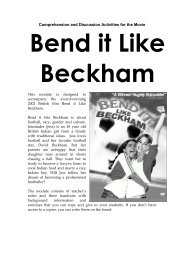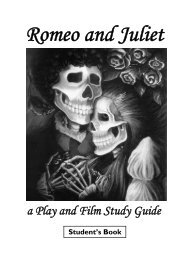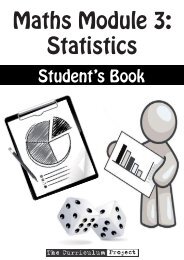Rabbit-Proof Fence N.. - The Curriculum Project
Rabbit-Proof Fence N.. - The Curriculum Project
Rabbit-Proof Fence N.. - The Curriculum Project
Create successful ePaper yourself
Turn your PDF publications into a flip-book with our unique Google optimized e-Paper software.
Comprehension and Discussion Activities for the Movie<br />
RABBIT-PROOF<br />
FENCE<br />
This module has been designed to accompany the film <strong>Rabbit</strong>-<strong>Proof</strong> <strong>Fence</strong> (2002).<br />
<strong>Rabbit</strong>-<strong>Proof</strong> <strong>Fence</strong> tells the true story<br />
of three Aboriginal Australian girls<br />
– Molly, her sister Daisy and their<br />
cousin, Gracie. It is based on the<br />
book Follow the <strong>Rabbit</strong>-<strong>Proof</strong> <strong>Fence</strong> by<br />
Doris Pilkington Garimara, Molly’s<br />
daughter. When Molly was 14,<br />
Gracie 10 and Daisy 8, the<br />
Australian government took them<br />
from their home to train them as<br />
servants for the white settlers. <strong>The</strong><br />
girls decided to escape and walk<br />
home, following the “rabbit-proof<br />
fence”.<br />
This film follows the girls’ 1,500<br />
mile walk home, avoiding capture<br />
and surviving in the wild. It also<br />
tells the larger story of Australia’s<br />
‘Stolen Generations’ – thousands of<br />
Aboriginal children who were taken<br />
from their homes by the<br />
government. Many of these children<br />
never saw their parents again.<br />
This module consists of teacher’s notes and handouts to copy and give to<br />
your students. If you don’t have access to a copier, write the exercises on the<br />
board. You might like to do some of these activities in students’ first<br />
language. It is important that they understand the ideas behind the story, and<br />
this is easier in their own language.
1. Before You Watch<br />
1.1: Australia past and present<br />
Give copies of Worksheet 1: Background Information to your students, or put the<br />
worksheets where all students can see them.<br />
Exercise A: Look at the map of Australia and the images of modern Australia.<br />
1. Students match the pictures with the captions.<br />
2. Brainstorm about Australia. Who lives there? What is the environment<br />
like? Write students’ ideas on the board.<br />
Exercise B: Look at the images of historical Australia.<br />
1. Students match the pictures with the captions.<br />
2. What do they think life was like for Aboriginal people? Write students’<br />
ideas on the board.<br />
Exercise C: Useful vocabulary.<br />
1. Students read through the vocabulary and definitions, and answer the questions.<br />
Discuss the words that they don’t understand.<br />
Answers to Exercise C:<br />
1. F - ‘Half-caste’ was the name used for someone who was of mixed Aboriginal and<br />
European heritage. This term is no longer acceptable in Australia and most<br />
Aboriginal Australians would be offended by its use.<br />
2. T<br />
3. T<br />
4. F - Indigenous people are the first, or original, people living in a given place.<br />
5. F - A racist believes that his/her race is better than others.<br />
2. While You Watch<br />
2.1: Home in Jigalong and the Aborigines Act 00.00 – 07.00<br />
Give copies of Worksheet 2: While You Watch to your students, or write the questions<br />
on the board. Play the film to 07:00.<br />
Answers to 2.1<br />
Exercise A:<br />
1. Molly and Daisy are sisters and Gracie is their cousin.<br />
2. <strong>The</strong> Jigalong tribe is a desert people.<br />
3. <strong>The</strong> Australian government gives the Jigalong tribe rations including flour,<br />
tobacco and tea.<br />
4. Molly’s mother tells her that the spirit bird will always look after her.<br />
5. A.O. Neville is the legal guardian of all Aboriginals in Western Australia and he<br />
has the power to remove any Aboriginal child from their home. His office is in<br />
Perth.<br />
Teacher’s Notes
Exercise B:<br />
1. <strong>The</strong>y are following the tracks of a giant lizard until Molly catches it. This shows<br />
the community’s lifestyle of hunting and gathering, and of interacting closely<br />
with each other and the earth. It also shows the girls’ skill in the outdoors,<br />
particularly Molly’s.<br />
2. <strong>The</strong> girls’ fathers are all white men who used to work on the fence. <strong>The</strong>y have<br />
‘moved on’.<br />
3. Because the policemen are looking for ‘half-caste’ children so they can take them<br />
away.<br />
4. To marry, visit their children at Moore River, and buy shoes.<br />
2.2: Capture and Moore River Native Settlement 07:00 – 27:50<br />
Play the film to 27:50. If the students don’t have Worksheet 2, write the exercises on the<br />
board.<br />
Answers to 2.2<br />
Exercise A:<br />
1. T<br />
2. T<br />
3. F - <strong>The</strong> girls go to Moore River by train, inside a large cage/holding cell and then<br />
in the back of a truck.<br />
4. F - <strong>The</strong>y were trained to be house help and/or farm labour for white Australians.<br />
5. F - <strong>The</strong>re are very young babies who have been separated from their birth mothers<br />
at Moore River.<br />
6. F - Children with the lightest skin were separated and sent to a “proper school”.<br />
Exercise B:<br />
1. Some of the rules include: standing and sitting when told to, eating with Western<br />
utensils (forks, spoons and knives), not speaking while eating, saying Christian<br />
prayers and only speaking English/not speaking their native languages.<br />
2. Modoo is the tracker and he is Aboriginal. It is his responsibility to find any child<br />
who runs away from Moore River. His daughter, Olive, lives at Moore River.<br />
Exercise C:<br />
3. Neville’s plan was to take all light-skinned Aboriginal children (those believed to<br />
have a European parent or grandparent) and forcibly assimilate them into white<br />
society, either through adoption or by training them to work as house servants<br />
and farm labour. Neville said he wanted to give these “half-caste” children the<br />
“benefits” of white society.<br />
4. Neville believed that his plan would allow “half-caste” children to become white so<br />
that there was no longer an unwanted “third race”. Neville believed that in three<br />
generations the black colour would not exist anymore.<br />
5. In his opinion, the Aboriginal people were not wise enough to know what was best<br />
for them and that he and other Europeans knew better. He felt responsible for<br />
saving mixed-race children by giving them the “benefits” of white culture and<br />
society.<br />
Teacher’s Notes
2.3: Escape 27:50 – 47:00<br />
Play the film to 47:00. If students don’t have Worksheet 2, write the exercises on the<br />
board.<br />
Answers to 2.3<br />
Exercise A:<br />
1. Daisy 2. Neville 3. the woman from the house 4. Gracie 5. the hunter<br />
6. Molly<br />
Exercise B:<br />
1. <strong>The</strong> girls have an opportunity to escape when it is Molly’s turn to empty the toilet<br />
bucket and everyone else has gone to church. Molly tells her sister and cousin to<br />
run.<br />
2. Molly, Gracie and Daisy stay hidden from the tracker by doing things such as:<br />
Taking off their shoes while running<br />
Using the rain to cover their tracks<br />
Putting Daisy’s bag in the river<br />
Staying silent and always listening<br />
Hiding in the bush<br />
2.4: Following the <strong>Rabbit</strong> <strong>Proof</strong> <strong>Fence</strong> 47:00 – 1.10:21<br />
Play the film to 1.10.21. If students don’t have Worksheet 2, write the exercises on the<br />
board.<br />
Answers to 2.4<br />
Exercise A:<br />
1. Modoo 2. Gracie 3. Mavis 4. Daisy 5. Neville<br />
Exercise B:<br />
1. Neville sets a trap for the girls in two ways. First, he stations the men along the<br />
fence to wait for the girls, believing they will walk into the area where the men are<br />
waiting. Second, he tells everyone to spread the word that Gracie’s mother is<br />
waiting for her in Wiluna and that the girls can take a train there. Neville wants<br />
the girls to hear this and come to Wiluna, where it will be easier to catch them.<br />
2. Gracie turns around to run away from Molly and Daisy so that they will not get<br />
caught. <strong>The</strong> film does not tell us what happens to her after she gets caught. Ask<br />
students for suggestions. From the book, we know that she was sent back to Moore<br />
River and then worked on farms and in the city as domestic help.<br />
3. Perhaps Modoo works at Moore River so that he can see his daughter, Olive.<br />
Maybe being a tracker is a good job. He might not have a choice, and maybe he<br />
thinks he can help the children in small ways by staying there. Modoo seems<br />
sympathetic to Molly, Gracie and Daisy. He respects them for not getting caught<br />
and he smiles when the policeman he is with gives up and stops waiting for the<br />
girls. It is not clear if Modoo could have caught the girls if he had wanted to -<br />
what do your students think?<br />
4. Mavis is another Stolen Generations girl who is working as domestic help for a<br />
white family. She helps the girls by giving them food and a place to stay. Her life<br />
is difficult because she has to do what the white family tells her to do. She is also<br />
abused by the man of the house.<br />
Teacher’s Notes
2.5: Return 1.10:21 – end<br />
Play the film to the end. If students don’t have Worksheet 2, write the exercises on the<br />
board.<br />
Answers to 2.5<br />
Exercise A:<br />
1. <strong>The</strong>y see the spirit bird. This is important because it symbolises home and is<br />
meant to always lead them where they need to go. Molly says “home”, and then<br />
calls out to the bird.<br />
2. <strong>The</strong>y are sitting together chanting, singing and waiting for the girls to return.<br />
This shows their deep connection to the girls. Perhaps the women are doing this to<br />
send the girls strength and guide them home.<br />
3. Molly says “I lost one. I lost one” in reference to Gracie.<br />
4. <strong>The</strong>y hid in the desert so that they would not be captured again. Molly eventually<br />
married and had two daughters. She and her daughters were captured again and<br />
taken back to Moore River. Molly escaped for a second time and walked all the<br />
way back to Jigalong, carrying the smaller daughter, Annabelle. When Annabelle<br />
was three, she was recaptured and Molly never saw her again.<br />
5. Gracie never returned to Jigalong. She never got to see Molly, Daisy or her family<br />
again. In the book (not the film), Molly’s daughter writes that Gracie got married<br />
and had six children, but she died in 1983.<br />
Exercise B:<br />
Answers to these questions will vary. Encourage students to openly debate and discuss.<br />
1. - Neville thinks he is protecting the Aboriginal people, but he is also protecting the<br />
white Europeans and the idea of colonialism itself. <strong>The</strong> Aboriginal people are seen<br />
as a threat to colonialism. <strong>The</strong> title ‘Chief Protector’ is a contradiction because in<br />
reality he is not protecting the Aboriginals, but hurting them by taking away the<br />
children. This is why the children call him Devil (and it rhymes with his name).<br />
2. - many white Europeans were racist. <strong>The</strong>y believed they were more intelligent,<br />
superior and knew better than the Aboriginal Australians<br />
- they did not understand indigenous society and customs. Consequently, they<br />
thought Aboriginal Australians were uncivilised and uneducated.<br />
- they felt threatened by indigenous populations and wanted to control them. <strong>The</strong>y<br />
especially wanted to control the ‘half-caste’ children because these children were<br />
‘half white’ and could, with the right training, be taught to ‘become fully white’.<br />
This would eventually lead to the ‘breeding out’ of black Aboriginals.<br />
- they believed that their culture, customs and religion (Christianity) were<br />
superior and that these children, who were half white, needed to be saved. <strong>The</strong>y<br />
believed they were doing the right thing.<br />
Teacher’s Notes
3. After You Watch<br />
3.1: <strong>The</strong> ‘Stolen Generations’<br />
<strong>The</strong> end of <strong>Rabbit</strong>-<strong>Proof</strong> <strong>Fence</strong> states:<br />
Aboriginal children were forcibly removed from their families throughout Australia<br />
until 1970. Today many of these Aboriginal people continue to suffer from this<br />
destruction of identity, family life and culture. We call them the Stolen Generations.<br />
<strong>The</strong> concept of the Stolen Generations is still controversial in Australia. Some<br />
Australians deny the idea, while others recognise it and agree that these children<br />
and their families suffered greatly. In 2008, the Australian government publicly<br />
acknowledged and apologised for the policies, which caused the Stolen<br />
Generations.<br />
In groups, students discuss the following questions.<br />
-‐ What is their opinion on the Stolen Generations?<br />
-‐ Why do they think some Australians deny the idea of the Stolen<br />
Generations?<br />
-‐ What do they think the impact of the Stolen Generations has been on the<br />
Australian Aboriginal community? Encourage them to think about the<br />
effects on the children, as well as on the communities in general.<br />
-‐ How do they think the Australian Aboriginals’ situation is in Australia<br />
today? What problems might there be between them and the government?<br />
-‐ Do they think the government has a responsibility to help them?<br />
Why/why not?<br />
-‐ Can they think of examples from their own society/country that may have<br />
a similar history?<br />
This information is not part of the film, so students will have to use their<br />
imaginations.<br />
Your students can do extra research about lifestyles, traditions, history or<br />
achievements of Aboriginal Australian people as a follow up assignment, if the<br />
internet or other sources are available.<br />
Teacher’s Notes
Worksheet 1: Background Information<br />
Exercise A: Images of modern Australia<br />
1.<br />
2.<br />
3.<br />
4.<br />
5.<br />
6.<br />
a. a kangaroo<br />
b. the Sydney Opera House and Sydney Harbour Bridge<br />
c. a koala<br />
d. a family at Australia Day celebrations<br />
e. the Australian flag<br />
f. Australia and Southeast Asia<br />
Student’s Worksheet
Exercise B: Images of historical Australia<br />
1.<br />
2.<br />
3.<br />
a. traditional temporary home<br />
b. prisoners<br />
c. Aboriginal girls in a ‘Native Settlement’<br />
d. traditional dance<br />
e. an advertisement for homes for<br />
Aboriginal girls<br />
4.<br />
5.<br />
Student’s Worksheet
A Brief History of Australia<br />
Aboriginal (indigenous) Australians were the first people on the Australian continent.<br />
<strong>The</strong>y arrived in Australia from Asia more than 40,000 years ago. Although there are<br />
many Aboriginal groups, with their own languages, customs and cultures, they have some<br />
practices in common, including a close relationship with the earth and a rich tradition of<br />
oral story telling. Aboriginal Australians were traditionally hunter-gatherers.<br />
<strong>The</strong> British set up their first official camp in Eastern Australia in 1788. Soon after, British<br />
colonial officers travelled to Western Australia (WA) and began to claim Aboriginal<br />
lands as their own. Fighting broke out as Aboriginal Australians resisted European<br />
control. This resistance was violently repressed and many Aboriginal Australians were<br />
imprisoned or exploited for their labour.<br />
<strong>The</strong> first European government of Western Australia saw the Aboriginal Australians as a<br />
problem that needed to be controlled. Colonial officials introduced policies that oppressed<br />
and harmed Aboriginal communities for many years. One of these policies - the 1905<br />
Aborigines Act - granted the government legal control of all Aboriginal people living in<br />
its territory. <strong>The</strong> colonial government appointed a ‘chief protector’ to oversee all<br />
Aboriginal affairs.<br />
In 1911, the WA Chief Protector, A.O. Neville, introduced a policy to remove all part<br />
Aboriginal children from their families. Neville was worried about the creation of a ‘third<br />
race’ - people of mixed Aboriginal and European descent. Under his policy, mixed<br />
descent Aboriginal children were forcibly removed from their homes and sent to<br />
government or church-run institutions such as missions, orphanages and reserves. Some<br />
were also adopted or housed temporarily with foster families. <strong>The</strong>y were taught to forget<br />
their culture so that they could, in time, be assimilated into the white population. Many of<br />
these children never saw their birth parents again. While Aboriginal Australians were<br />
formally recognized as citizens of Australia in 1967, it was not until 2008 that the<br />
Australian government officially apologized for the policies that created the Stolen<br />
Generations.<br />
While Aboriginal Australians continue to struggle with the impacts of colonisation on<br />
their society and culture, many have achieved success in different areas, and Aboriginal<br />
Australian art and music is now celebrated all over the world.<br />
Student’s Worksheet
Useful Vocabulary<br />
Aboriginal Australian: a person belonging to the native/indigenous communities<br />
of Australia who lived there before Europeans arrived<br />
colonisation: when one country sends a group of people to take political control of<br />
another place<br />
constable: a police officer<br />
(cultural) assimilation: when a minority group adapts to the culture of the majority<br />
group and loses parts of its own culture in the process<br />
desert: a large, sandy area of land with little rainfall, extreme temperatures and<br />
not much vegetation<br />
discrimination: treating people differently because of their membership of<br />
categories, such as sex, religion, nationality, skin colour or age<br />
indigenous people: the first or earliest people living in a place<br />
mixed-race: a name for a person of mixed racial background. In Australia, it meant<br />
someone who was part Aboriginal and part European (‘half-caste’ and ‘mixedblood’<br />
mean the same thing but are impolite and should not be used)<br />
racism: the belief that some races are better than others<br />
tracker: someone who knows how to read the land well and who can help other<br />
people to find missing persons, food, water or animals<br />
Exercise C: True or false? If false, write the correct sentence.<br />
1. A ‘half-caste’ was the name for someone who had 100% Aboriginal<br />
Australian blood.<br />
2. When people adopt another culture and lose part of their own, we say<br />
they have ‘assimilated’.<br />
3. Discrimination is when people treat other people unfairly based on<br />
their age, sex, skin colour or nationality.<br />
4. Indigenous people are people who move to a country to take control of<br />
it<br />
5. A racist believes that all races are equal.<br />
Student’s Worksheet
Worksheet 2: While You Watch<br />
2.1: Home in Jigalong and the Aborigines Act 00.00 – 07.00<br />
Exercise A: Complete the following sentences with words from the box.<br />
spirit bird A.O. Neville Perth tea Gracie desert<br />
1. Molly and Daisy are sisters and ___________ is their cousin.<br />
2. <strong>The</strong> Jigalong tribe is a ___________ people.<br />
3. <strong>The</strong> Australian government gives the Jigalong tribe rations including<br />
flour, tobacco and ___________.<br />
4. Molly’s mother tells her that the ___________ will always look after her.<br />
5. ___________ is the legal guardian of all Aboriginals in Western Australia.<br />
He has the power to remove any Aboriginal child from their home. His<br />
office is in ___________.<br />
Exercise B: Answer the questions below.<br />
1. What are the girls doing at the beginning of the film? What does this tell<br />
us about their culture and way of life?<br />
2. Who are the fathers of Molly, Gracie and Daisy? Where have they gone?<br />
3. Why does Molly’s mother tell the children to hide when she sees the<br />
policemen?<br />
4. What three things do Aboriginal people need to ask Mr. Neville’s<br />
permission to do?<br />
2.2: Capture and Moore River Native Settlement 07:00 – 27:50<br />
Exercise A: True or false? If false, write the correct sentence.<br />
1. <strong>The</strong> rabbit-proof fence is the longest fence in the world and goes all the<br />
way to the sea.<br />
2. Constable Riggs threatens that if Gracie moves from the car, he will lock<br />
her mother up.<br />
3. <strong>The</strong> girls go to Moore River in a car.<br />
4. <strong>The</strong> Moore River Native Settlement was established to train Aboriginal<br />
children to go to university.<br />
5. <strong>The</strong> children at Moore River are all six years old and older.<br />
6. Children with the lightest skin are removed from Moore River and sent<br />
back to their families.<br />
Exercise B: Answer the questions below.<br />
1. What are some of the rules at Moore River that the children must follow?<br />
2. Who is Moodoo?<br />
Student’s Worksheet
Exercise C: Discuss the following statement as a class.<br />
“For if we are to fit and train such children for the future, they cannot be left as they are,<br />
and in spite of himself, the native must be helped.” - A.O. Neville<br />
1. What was Neville’s plan to ‘help’ Aboriginal children?<br />
2. What did Neville believe would happen to ‘mixed blood’ and ‘full blood’<br />
Aboriginal people once his plan was implemented?<br />
3. What did he mean by “in spite of himself, the native must be helped”?<br />
2.3: Escape 27:50 – 47:00<br />
Exercise A: Match the quote with the person who said it.<br />
Gracie the hunter Neville Molly Daisy the woman from the house<br />
1. “We don’t know this place. How we gonna eat?”<br />
2. “Those three girls. <strong>The</strong>y’ve run off. Maybe the older one, I wondered<br />
when I saw her, too much of their mind. Unfathomable. <strong>The</strong> tracker’s onto<br />
it. In the meantime, it must be kept out of the papers.”<br />
3. “And watch out for those boys further along, they go hunting rabbits<br />
along the fence… Yes, the rabbit-proof fence.”<br />
4. “We like it here.”<br />
5. “You know what you’re doing? That tracker from Moore River, he pretty<br />
good. I heard he get them runaways all the time. Gotta be good to beat<br />
him. He’ll take you back to that place.”<br />
6. “Make me sick, these people. Sick.”<br />
Exercise B: Discuss the following questions in groups or as a class.<br />
1. How do Molly, Gracie and Daisy escape from Moore River?<br />
2. What are some of the things the girls do to stay hidden from the tracker?<br />
2.4: Following the <strong>Rabbit</strong>-<strong>Proof</strong> <strong>Fence</strong> 47:00 – 1.10:21<br />
Exercise A: Match the quote with the person who said it.<br />
Neville Mavis Modoo Gracie Daisy<br />
1. “She pretty clever, that girl. She wants to go home.”<br />
2. “We on the wrong fence.”<br />
3. “Don’t go Molly. Please don’t go. He come back if you go.”<br />
4. “She gone, Molly. She not coming back.”<br />
5. “People fail to understand that the problem of the half-caste is not simply<br />
going to go away. If it is not dealt with now, it will fester for years to<br />
come. <strong>The</strong>se children are that problem.”<br />
Student’s Worksheet
Exercise B: Discuss the following questions in groups or as a class.<br />
1. What is the trap that Neville sets for the girls?<br />
2. At the train station, why does Gracie turn around and run away from<br />
Molly and Daisy? What do you think will happen to Gracie now?<br />
3. Why do you think Modoo works as a tracker? What does he think about<br />
Molly, Gracie and Daisy? Is he really unable to catch them?<br />
4. Who is Mavis? What evidence is there to suggest that life is difficult for<br />
Mavis?<br />
2.5: Return 1.10:21 – end<br />
Exercise A: Answer the questions below.<br />
1. What do Molly and Daisy see when they wake up in the desert? Why is it<br />
important? What does Molly say and do?<br />
2. What are Molly and Daisy’s mother and other women from their<br />
community doing before the girls arrive? Why?<br />
3. What does Molly say when she sees her mother?<br />
4. What do Molly and Daisy do when they reach Jigalong? What happens to<br />
them into the future?<br />
5. What happened to Gracie?<br />
Exercise B: Discuss the following questions in groups or as a class.<br />
At the end of the film, A.O. Neville states:<br />
“We face an uphill battle with these people, especially the bush natives, who have to be<br />
protected against themselves. If they would only understand what we are trying to do for<br />
them.”<br />
1. Neville’s official title is ‘Chief Protector’ yet the children at Moore River<br />
call him ‘Devil’. Who is Neville protecting? Why do the children call him<br />
‘Devil’? How would you describe him? Why?<br />
2. Why do you think the Aborigines Act and related policies were accepted<br />
and promoted in Western Australia.<br />
Student’s Worksheet
Plot Summary<br />
<strong>Rabbit</strong>-<strong>Proof</strong> <strong>Fence</strong> tells the story of three Australian Aboriginal girls – Molly<br />
Craig, Gracie Fields and Daisy Karnpill Craig – and their dramatic escape and<br />
walk home from the Moore River Native<br />
Settlement in the year 1931.<br />
At the start of the film, we see Molly, Gracie and<br />
Daisy hunting with their mothers in Jigalong, the<br />
remote area in which they live. We then see A.O<br />
Neville, the Chief Protector of the Aboriginals in<br />
Western Australia. He believes that removing<br />
children of mixed European/Aboriginal heritage<br />
from their families is good for them.<br />
A.O. Neville orders the local policeman, Constable<br />
Riggs, to capture Molly, Gracie and Daisy, who<br />
have European fathers. Riggs captures the girls one<br />
afternoon and sends them to the Moore River<br />
Native Settlement. At Moore River, the girls are<br />
trained to talk and act like white Australians.<br />
Children at Moore River are not allowed to speak<br />
their language or practice their customs and<br />
culture. Instead they must speak English, learn Christianity and other<br />
European practices. Molly, Gracie and Daisy enter a scary new world. <strong>The</strong>y<br />
are unsure of how to behave and face severe punishment for breaking the<br />
rules.<br />
Map of the <strong>Rabbit</strong>-<strong>Proof</strong> <strong>Fence</strong><br />
Molly, the oldest of the three girls, organises to escape from Moore River with<br />
her sister and cousin. <strong>The</strong> girls head north and, after getting some information<br />
from a woman who feeds them, are able to find the rabbit-proof fence which<br />
Molly knows will lead them home. <strong>The</strong> girls must walk 1,500 miles (2414km)<br />
through difficult conditions. <strong>The</strong> girls are chased by Modoo, an Aboriginal<br />
Australian tracker, and by Constable Riggs. <strong>The</strong> girls meet a collection of<br />
strangers along the way who provide food as well as advice – both good and<br />
bad. Some of this advice convinces Gracie to stop walking and results in her<br />
re-capture.<br />
As Molly and Daisy near home, the rabbit-proof fence stops and they find<br />
themselves in the extreme desert and they collapse from exhaustion. At the<br />
same time, women in their community in Jigalong are chanting and sending<br />
them strength. When the girls wake up in the desert, the spirit bird appears,<br />
and they find the strength to walk the rest of the way home. When they<br />
arrive, they must immediately hide so that they are not recaptured. <strong>The</strong> film<br />
ends with images of the real-life Molly and Daisy walking in Jigalong. <strong>The</strong>y<br />
say they will never go back to ‘that place’ – Moore River.


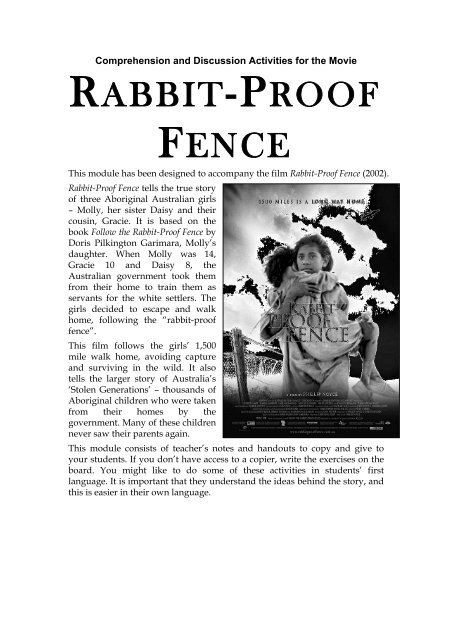
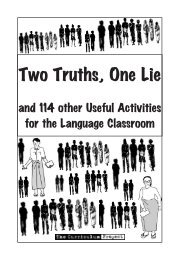
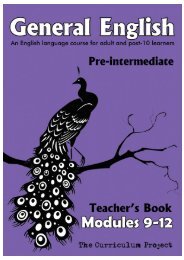
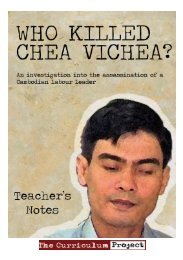

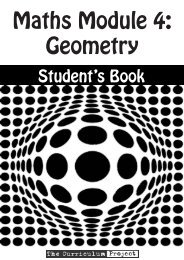

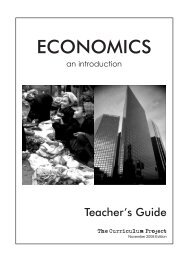
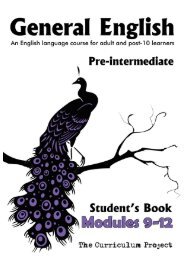

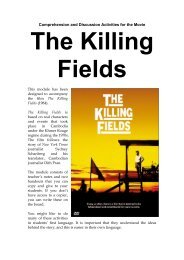
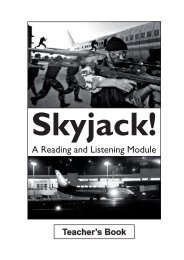
![[Eng] Nov 2012 DRAFT - The Curriculum Project](https://img.yumpu.com/45590859/1/184x260/eng-nov-2012-draft-the-curriculum-project.jpg?quality=85)
